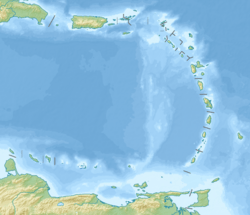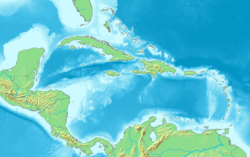Thatch Cay, U.S. Virgin Islands facts for kids
| Geography | |
|---|---|
| Location | Caribbean Sea |
| Coordinates | 18°21′32″N 64°51′22″W / 18.359°N 64.856°W |
| Archipelago | Virgin Islands, Leeward Islands |
| Area | 230 acres (93 ha) |
| Administration | |
| Insular area | Virgin Islands |
| Largest settlement | Charlotte Amalie (pop. 18,481) |
| Demographics | |
| Population | 51,634 (2010) |
| Pop. density | 638.17 /km2 (1,652.85 /sq mi) |
| Ethnic groups | Afro-Caribbean, Hispanic, Caucasian |
Thatch Cay is a small island in the Caribbean Sea. It is located off the northeastern coast of Saint Thomas. The island is about 230 acres (931,000 square meters) in size. It is currently uninhabited, meaning no one lives there. Thatch Cay is also one of the last privately owned, undeveloped islands in the U.S. Virgin Islands. Its highest point reaches about 482 feet (147 meters) above sea level.
Contents
History of Thatch Cay
How Thatch Cay Got Its Name
Thatch Cay gets its name from a special type of palm tree. These trees are called Tyre palms (Coccothrinax alta). They grow in thick groups all over the island. Long ago, people used the leaves from these palms to make sacks. They also used them to create roofs for their buildings.
Early Owners and Life on the Island
In 1804, a family from Denmark called the Reycks owned Thatch Cay. They were the first people known to live on the island. They started a small farm called "The Hope." The Reyck family had fourteen members living there. They also had two enslaved people who were forced to work on the farm.
It is not known exactly when the Reyck family stopped owning the island. However, it is thought to be around 1917. This was when the U.S. Government bought almost all of the islands in the chain.
Later Settlements and Discoveries
In the middle of the 1900s, a small fishing village was on Thatch Cay. It had six small buildings. There was also a small copper mine on the island. Today, you can still see the stone ruins of these old buildings.
Wildlife on Thatch Cay
Thatch Cay has always been known for its many lobsters. A type of lobster called the Panulirus argus is found in large numbers around the island. These lobsters are an important part of the island's natural environment.
See also
 In Spanish: Cayo Thatch para niños
In Spanish: Cayo Thatch para niños




